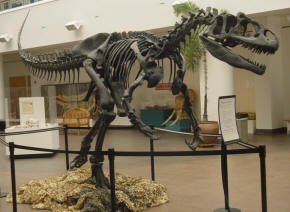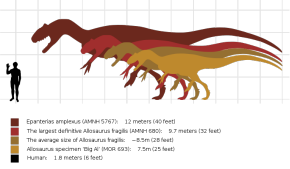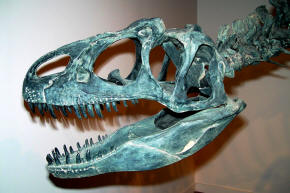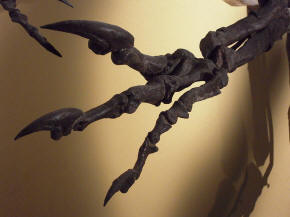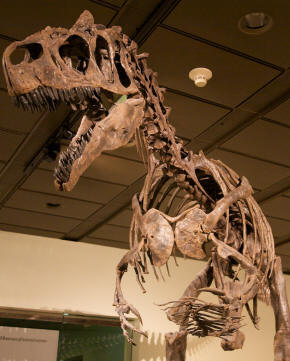|
Allosaurus
was a typical large theropod, having a massive skull on a short neck, a long tail and reduced
forelimbs.
Allosaurus fragilis,
the best-known species, had an average length of 8.5 meters (28 ft), with
the largest definitive Allosaurus
specimen (AMNH
680) estimated at 9.7 meters long (32 ft), and an estimated weight of 2.3 metric
tons (2.5 short
tons). As with dinosaurs in general,
weight estimates are debatable. Since 1980 estimates for Allosaurus have
ranged between 700 kg (1,500 lbs) and 4,000 kg (8,800 lbs). Using the subadult specimen nicknamed "Big Al", researchers using
computer modelling arrived at a best estimate of 1,500 kilograms (3,300 lb)
for the individual, but by varying parameters they found a range from
approximately 1,400 kilograms (3,100 lb) to approximately 2,000 kilograms
(4,400 lb).
The bulk of Allosaurus
remains have come from North America's
Morrison Formation,
with material also known from Portugal and possibly
Tanzania. As the prominent large predator in
the Morrison Formation,
Allosaurus was at
the top of the food chain, probably
preying on contemporaneous large herbivorous dinosaurs and perhaps even
other predators (e.g.
Ceratosaurus).
Potential prey included
ornithopods,
stegosaurids, and
sauropods. Some
paleontologists interpret Allosaurus
as having had cooperative social behavior, and
hunting in packs, while others believe individuals may have been aggressive
toward each other, and that congregations of this genus are the result of
lone individuals feeding on the same carcasses. It may have attacked large
prey by ambush, using its upper jaws like a hatchet.
Physical Description
Skull
The skull and teeth of
Allosaurus were modestly
proportioned for a theropod of its size. Paleontologist
Gregory S. Paul gives a
length of 33.3 inches for a skull belonging to an individual
he estimates at 26 feet long. Each
premaxilla (the bones
that formed the tip of the snout), held five teeth with D-shaped
cross-sections, and each
maxilla (the main
tooth-bearing bones in the upper jaw) had between fourteen and seventeen
teeth; the number of teeth does not exactly correspond to the size of the
bone. Each dentary (the
tooth-bearing bone of the lower jaw) had between fourteen and seventeen
teeth, with an average count of sixteen. The teeth became shorter, more
narrow, and more curved toward the back of the skull. All of the teeth had
saw-like edges. They were shed easily, and were replaced continually, making
them common fossils.
Inside the lacrimal bones were
depressions that may have held glands, such as
salt glands. Within the
maxillae were
sinuses that were
better developed than those of more
basal theropods such as
Ceratosaurus and
Marshosaurus; they may
have been related to the sense of smell, perhaps
holding something like
Jacobson's organ. The
roof of the braincase was thin, perhaps to improve
thermoregulation for
the brain. The skull and
lower jaws had joints that permitted motion within these units. In the lower
jaws, the bones of the front and back halves loosely articulated, permitting
the jaws to bow outward and increasing the animal's gape.
Postcranial skeleton
Allosaurus
had nine
vertebrae in the neck,
fourteen in the back, and five in the
sacrum supporting the
hips. The number of tail vertebrae is unknown and varied with individual
size, estimated to be 45 to 50. There were hollow spaces in the
neck and
anterior back
vertebrae. Such spaces, which are also found in modern theropods (that is,
the birds), are interpreted as having held
air sacs used in respiration. The rib
cage was broad, giving it a barrel chest, especially in comparison to less
derived theropods like
Ceratosaurus.
Allosaurus had
gastralia (belly ribs),
but these are not common findings, and they may have
ossified poorly. In one
published case, the gastralia show evidence of injury during life. A
furcula (wishbone) was
also present, but has only been recognized since 1996; in some cases
furculae were confused with gastralia. The
ilium, the main hip
bone, was massive, and the
pubic bone had a
prominent foot that may have been used for both muscle attachment and as a
prop for resting the body on the ground.
The forelimbs of
Allosaurus were short in
comparison to the hindlimbs (only about 35% the length of the hindlimbs in
adults) and had three fingers per hand, tipped with large, strongly curved
and pointed claws. The arms were
powerful, and the forearm was somewhat shorter than the upper arm). The wrist had a version of the semilunate
carpal also found in
more derived theropods like
maniraptorans. Of the
three fingers, the innermost (or
thumb) was the largest,
and diverged from the others. The legs were not as long or suited for speed
as those of
tyrannosaurids, and the
claws of the toes were less developed and more
hoof-like than those of
earlier theropods. Each foot had three
weight-bearing toes and an inner
dewclaw, which could have been used for grasping in juveniles. There was also
what is interpreted as the splint-like remnant of a fifth (outermost)
metatarsal, perhaps
used as a lever between the
Achilles tendon and
foot.
Classification
|
Scientific Classification
|
|
Allosaurus
was an allosaurid, a member of a family of large
theropods within the larger group
Carnosauria. The family
name
Allosauridae was
created for this genus in 1878 by
Othniel Charles Marsh,
but the term was largely unused until the 1970s in favor of
Megalosauridae, another
family of large theropods that eventually became a
wastebasket taxon.
This, along with the use of Antrodemus
for Allosaurus
during the same period, is a point that needs to be remembered when
searching for information on Allosaurus
in publications that predate James Madsen's 1976 monograph.
Allosauridae is one of three
families in Carnosauria; the other two are
Carcharodontosauridae
and
Sinraptoridae.
Allosauridae has at times been proposed as ancestral to the
Tyrannosauridae (which
would make it
paraphyletic), but this has been
rejected, with tyrannosaurids identified as members of a separate branch of
theropods, the
Coelurosauria.
Allosauridae is the smallest of the carnosaur families, with only
Saurophaganax and a
currently unnamed French
allosauroid accepted as
possible valid
genera besides
Allosaurus in the most
recent review.
Species and taxonomy
It is unclear how many species of
Allosaurus there were. Seven
species have been considered potentially valid since 1988 (A. amplexus,
A. atrox,
A. europaeus,
the
type species A. fragilis,
the as-yet not formally described "A. jimmadseni",
A. maximus,
and A. tendagurensis),
although only a fraction are usually considered valid at any given time.
Additionally, there are at least ten dubious or undescribed species that
have been assigned to Allosaurus over the years, along with the
species belonging to genera now sunk into Allosaurus. In the most
recent review of basal
tetanuran
theropods, only A. fragilis (including
A. amplexus and
A.
atrox as synonyms), "A. jimmadseni" (as an unnamed species), and
A.
tendagurensis were accepted as potentially valid species, with
A.
europaeus not yet proposed and
A. maximus assigned to
Saurophaganax.
A. amplexus,
A. atrox,
A. fragilis, "A. jimmadseni",
and A. maximus are all known from remains discovered in the
Kimmeridgian–Tithonian
Upper Jurassic-age Morrison Formation of the
United States, spread across the states of
Colorado,
Montana,
New
Mexico,
Oklahoma,
South Dakota, Utah, and Wyoming. A. fragilis is regarded as the
most common, known from the remains of at least sixty individuals.
Debate has gone on since the 1980s regarding the possibility that there are
two common Morrison Formation species of Allosaurus, with the second
known as A. atrox;
recent work has followed a "one species" interpretation,
with the differences seen in the Morrison Formation material attributed to
individual variation. A. europaeus was found in the Kimmeridgian-age Porto Novo Member of
the
Lourinhã Formation,
but may be the same as A. fragilis.
A. tendagurensis was found in Kimmeridgian-age rocks of
Tendaguru,
in
Mtwara, Tanzania.
Although the most recent review tentatively accepted it as a valid species
of Allosaurus, it may be a more basal tetanuran,
or simply a
dubious theropod.
Although obscure, it was a large theropod, possibly around 10 meters long
(33 ft) and 2.5 metric tons (2.8 short tons) in weight.
Discovery
and history
Early discoveries and research
The discovery and early study of
Allosaurus is
complicated by the multiplicity of names coined during the
Bone Wars of the late
1800s. The first described fossil in this history
was a bone obtained secondhand by
Ferdinand Vandiveer Hayden
in 1869. It came from
Middle Park, near
Granby, Colorado,
probably from
Morrison Formation
rocks. The locals had identified such bones as "petrified
horse hoofs". Hayden
sent his specimen to
Joseph Leidy, who
identified it as half of a tail vertebra, and tentatively assigned it to the
European dinosaur genus
Poekilopleuron as
Poicilopleuron
[sic] valens. He
later decided it deserved its own genus,
Antrodemus.
Allosaurus
itself is based on
YPM 1930, a small
collection of fragmentary bones including parts of three vertebrae, a rib
fragment, a tooth, a toe bone, and, most useful for later discussions, the
shaft of the right humerus (upper arm). Othniel Charles Marsh gave these
remains the formal name Allosaurus fragilis
in 1877. The bones were collected
from the Morrison Formation of
Garden Park, north of
Cañon City. Marsh and
Edward Drinker Cope,
who were in scientific competition, went on to coin several other genera
based on similarly sparse material that would later figure in the taxonomy
of Allosaurus.
These include Marsh's Creosaurus
and Labrosaurus,
and Cope's Epanterias.
In their haste, Cope and Marsh did
not always follow up on their discoveries (or, more commonly, those made by
their subordinates). For example, after the discovery by
Benjamin Mudge of the
type specimen of Allosaurus
in Colorado, Marsh elected to concentrate work in Wyoming; when work
resumed at Garden Park in 1883, M. P. Felch found an almost complete
Allosaurus and several
partial skeletons. In addition, one of Cope's collectors, H. F. Hubbell,
found a specimen in the
Como Bluff area of
Wyoming in 1879, but apparently did not mention its completeness, and Cope
never unpacked it. Upon unpacking in 1903 (several years after Cope had
died), it was found to be one of the most complete theropod specimens then
known, and in 1908 the skeleton, now cataloged as AMNH 5753, was put on
public view. This is the well-known mount poised over a partial
Apatosaurus skeleton
as if scavenging it,
illustrated as such by Charles R. Knight. Although notable as the first
free-standing mount of a theropod dinosaur, and often illustrated and
photographed, it has never been scientifically described.
The multiplicity of early names
complicated later research, with the situation compounded by the terse
descriptions provided by Marsh and Cope. Even at the time, authors such as
Samuel Wendell Williston
suggested that too many names had been coined. For example, Williston
pointed out in 1901 that Marsh had never been able to adequately distinguish
Allosaurus from
Creosaurus. The
most influential early attempt to sort out the convoluted situation was
produced by
Charles W. Gilmore in
1920. He came to the conclusion that the tail vertebra dubbed
Antrodemus by Leidy was
indistinguishable from those of Allosaurus,
and Antrodemus thus
should be the preferred name because as the older name it had priority.
Antrodemus became
the accepted name for this familiar genus for over fifty years, until James
Madsen published on the Cleveland-Lloyd specimens and concluded that
Allosaurus should be used
because Antrodemus
was based on material with poor, if any, diagnostic features and locality
information (for example, the geological formation
that the single bone of
Antrodemus
came from is unknown). "Antrodemus"
has been used informally for convenience when distinguishing between the
skull Gilmore restored and the composite skull restored by Madsen.
Cleveland-Lloyd discoveries
Although sporadic work at what
became known as the
Cleveland-Lloyd Dinosaur Quarry
in Emery County, Utah had taken place as
early as 1927, and the fossil site itself described by William J. Stokes in
1945, major operations did not begin there until 1960. Under a cooperative
effort involving nearly 40 institutions, thousands of bones were recovered
between 1960 and 1965. The quarry is notable for the predominance of
Allosaurus remains, the
condition of the specimens, and the lack of scientific resolution on how it
came to be. The majority of bones belong to the large theropod
Allosaurus fragilis (it is
estimated that the remains of at least 46 A.
fragilis have been found there, out of at
minimum 73 dinosaurs), and the fossils found there are disarticulated and
well-mixed.
|
Young Earth Creationists Claim
|
|
When it comes to dinosaur sites that have hundreds of animals
that have died in one location, young earth creationists claim that
this is evidence of the Flood of Noah. However, this ignores
the many other dinosaur remains that are found as individuals.
More importantly, it ignores the stratigraphic problem. The
rock layer where these allosaurs are found is located thousands of
feet above the point where they claim the flood rocks begin.
How did the dinosaurs survive the deposition of the first 10,000
feet of sediment? (For more, see
this article)
|
Nearly a dozen scientific papers have been written on the
taphonomy of the site,
coming up with numerous contradictory explanations for how it formed.
Suggestions have ranged from animals getting stuck in a bog, to becoming
trapped in deep mud, to falling victim to drought-induced
mortality around a waterhole, to getting trapped in a spring-fed pond or
seep. Regardless of the actual cause, the great quantity of well-preserved
Allosaurus remains
has allowed this genus to be known in detail, making it among the best-known
theropods. Skeletal remains from the quarry pertain to individuals of almost
all ages and sizes, from less than 1 meter (3.3 ft) to 12 meters (39 ft)
long, and the disarticulation is an advantage for describing bones usually
found fused.
Recent work:
1980s–present
The period since Madsen's monograph
has been marked by a great expansion in studies dealing with topics
concerning Allosaurus
in life (paleobiological
and paleoecological
topics). Such studies have covered topics including skeletal variation,
growth, skull construction, hunting methods, the brain, and the
possibility of gregarious living and parental care. Reanalysis of old
material (particularly of large 'allosaur' specimens), new discoveries in
Portugal, and several very complete new specimens have also contributed to
the growing knowledge base. Fossil footprints attributed to
Allosaurus were discovered
in Bałtów, Poland, by Polish
paleontologist Gerard Gierliński in the early 2000s.
"Big Al"
One of the more significant
Allosaurus finds was the 1991
discovery of "Big Al" (MOR
693), a 95% complete, partially articulated specimen that measured about
8 meters (about 26 ft) in length. MOR 693 was excavated near
Shell, Wyoming, by a joint Museum of the Rockies and
University of Wyoming Geological Museum team.
This skeleton was discovered by a Swiss team, led by Kirby Siber. The same
team later excavated a second Allosaurus, "Big Al Two", which is the
best preserved skeleton of its kind to date.
The completeness, preservation, and scientific importance of this
skeleton gave "Big Al" its name; the individual itself was below the average
size for Allosaurus fragilis,
and was a subadult estimated at only 87% grown.
Nineteen of its bones were broken or showed signs of
infection,
which may have contributed to "Big Al's" death.
Pathologic bones included five ribs, five vertebrae, and four bones of
the feet; several damaged bones showed
osteomyelitis, a bone infection. A particular problem for the living
animal was infection and trauma to the right foot that probably affected
movement and may have also predisposed the other foot to injury because of a
change in gait.
Return to the
Old Earth Ministries Online Dinosaur
Curriculum homepage.

Shopping
Many fine
reproductions of Allosaurus teeth, claws, skulls, and even complete
skeletons, are available from several companies. Please click the
links below to visit their websites.
Bay
State Replicas - Three skull varieties, complete hand, complete arm,
complete foot, complete leg, humerus, jaw w/teeth, foot claw, finger claw,
1st, 2nd, and 3rd digit fingers
Black
Hills Institute - Complete skeleton ($60,000), skull with neck, leg, femur, skull,
reproduction head (fleshed), tooth (in matrix)
|
